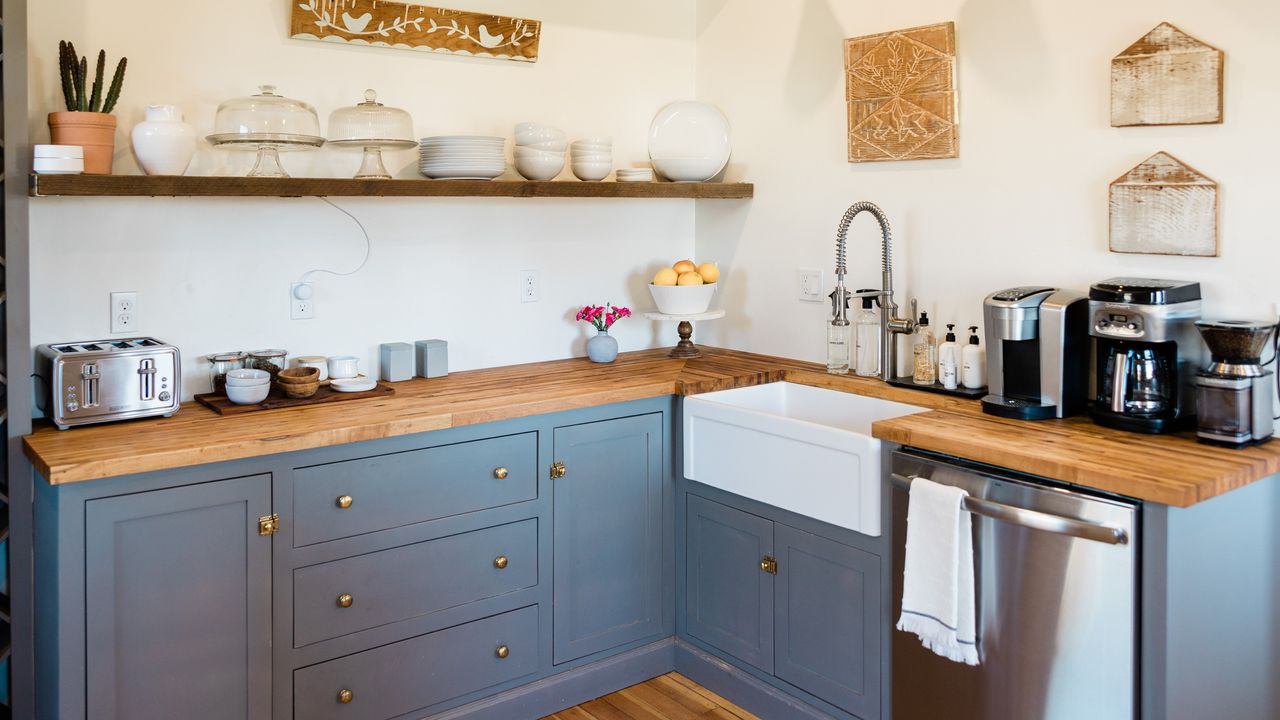

Finding the best kitchen worktops is something you should think about early on in a kitchen redesign. You may already have your other decorative kitchen ideas in place, your wall colors picked out, cabinets designed and an idea of the finish you want from your kitchen worktop, and so which type of countertop material you choose is vital to bring it all to life.
Whether it's wood or stone, composite or metal that you like the look of, finding a surface that will not only suit the look of your new kitchen but serve its purpose well also is important. Your kitchen worktop has to practically suit your needs too – there's no use using a delicate material if it will quickly scuff at the first use of your best kettle, or best air fryer.
From useable and cost-efficient countertop materials like laminate to stylish solid wood, marble, and more pricey options, we can help you make the right call on this hardworking surface. Keep scrolling to choose this vital element of your kitchen design, and get your kitchen into perfect shape.
Best kitchen worktops
Why you can trust Real Homes
Granite
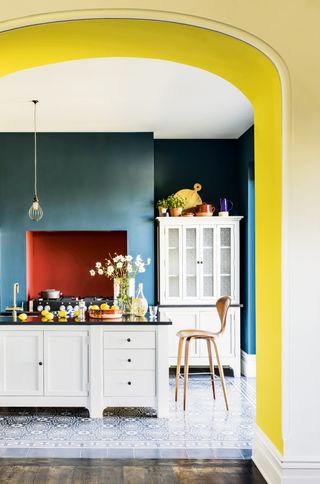
Granite kitchen worktops
Specifications
Reasons to buy
Reasons to avoid
What is granite?
‘Granite is the result of cooling pressurized magma over millions of years resulting in a rock that is both heat and scratch resistant. When sealed properly it is also stain resistant and, once installed, requires no more maintenance,’ says Jon Brewer, managing director and founder of Purple Granite.
How good is it as a kitchen worktop?
Granite is probably the most popular type of kitchen worktop. It is by far the most low-maintenance choice, so sturdy that it's unlikely to chip or scratch, and only needs to be resealed once a decade. Supremely heat-resistant, granite can easily withstand all your hot pans placed on top of it.
Ease of maintenance?
It's easy to keep clean too – it just needs a wipe with a soft microfibre cloth, warm water, and a mild soap or specialized granite spray, like this Weiman spray from Amazon. Avoid any harsh or abrasive cleaners and sponges.
Downsides?
The only thing to be mindful of is that you'll be that little bit more limited in your choice of a splashback: you can't have a coved backsplash in granite, so typically you'll need to go for a full-height panel splashback instead.
Plus you need to consider that this is a pretty pricey choice of kitchen worktop material..
Quartz
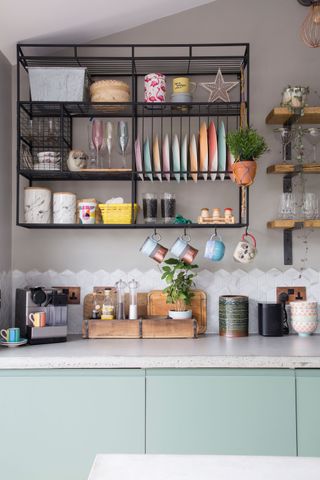
Quartz kitchen worktops
Specifications
Reasons to buy
Reasons to avoid
What is quartz?
A man-made alternative to materials such as granite and marble, industrial techniques are used to fortify natural quartz with resin to create a truly hard-wearing and customisable worktop.
‘Quartz has become ever more popular over the years and offers a more uniform, contemporary stone work-surface. It is naturally resistant to staining and scratching, but is less heat-resistant than granite, ‘ adds Jon Brewer of Purple Granite.
How good is it as a kitchen worktop?
One of the most attractive features of a quartz kitchen worktop is the combination of a natural stone look and feel with the low-maintenance properties that are usually expected from synthetic materials. Quartz is actually even more durable than granite, in the sense that it is even less prone to chipping and requires only occasional resealing. However unlike granite, it's not great with heat, so it won't be suitable to place hot pans or trays on.
Ease of maintenance
As with granite though, quartz surfaces are pretty easy to clean and maintain; for every day cleaning all you will need is a cloth and warm soapy water.
Downsides?
The biggest downside of a quartz kitchen worktop is the cost.
Hard wood
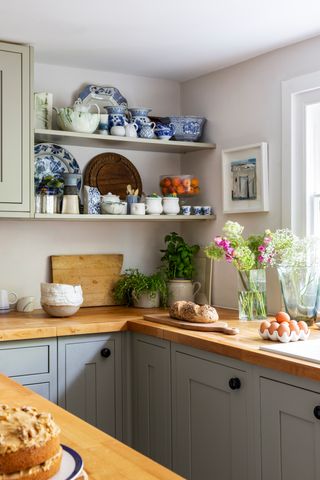
Hard wood kitchen worktops
Specifications
Reasons to buy
Reasons to avoid
What is a hard wood worktop made from?
For achieving a traditional look, maple, oak and beech work well. For a slightly more exotic feel, Wenge, bamboo or iroko are good options. Just make sure you always choose a sustainable hardwood, preferably from an FSC (Forest Stewardship Council) accredited source. It's one of the best kitchen worktops for country kitchens, giving that authentic rustic feel.
How good is it as a kitchen worktop?
In terms of price, wooden worktops can be pretty budget-friendly, depending on what type of wood you choose. If hardwoods are properly sealed and maintained they can last for ages, but the wood will change subtly over time, fading in bright sunlight in some cases or becoming deeper and richer with oiling. However, you may see this as a benefit, as the worktop will gain a beautiful patina and character. Plus, when it does come to scratches and stains, you can sand them away, which is not an option with other worktop surfaces.
Ease of maintenance
Wood can be trickier to maintain that granite and quartz. Make sure you wipe you any spills straight away and don't let the worktops come into contact with water for too long. Clean your wooden worktops with warm water, washing-up liquid and a soft cloth. Avoid using any abrasive and chemical-filled cleaning products and any harsh or wire scouring pads. See our guide to cleaning and maintaining wooden worktops for more on this.
The downsides?
The drawback with wood compared to stone or composite options is that it requires biannual oiling to keep away stains and damage. And, of course, you can't use the worktop as a chopping board, or place any hot pans directly onto the wood, as it can scorch.
Laminate
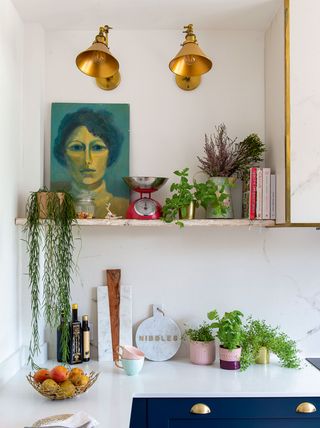
Laminate kitchen worktops
Specifications
Reasons to buy
Reasons to avoid
What is laminate?
Laminate is made by bonding a stiff sheet (which might have the appearance of wood, stone, or manmade materials) onto a wooden particleboard core.
How good is it as a kitchen worktop?
Laminate worktops are perfect for designing a kitchen on a budget. The upsides are that they're pretty resilient to stains and come in a vast range of finishes and colors, too. A big plus of laminate worktops? You can fit them yourself, even if you aren't a DIY expert.
Ease of maintenance
They can be wiped clean with most cleaning products, but be careful with knives, because once a laminate surface has a scratch, there is no easy way of getting it out.
The downsides?
Just be aware that laminate worktops may look good on paper, but you get what you pay for. They can be particularly prone to peeling or burns, so you need to be extra careful around them. Cheaper options will damage easily, too, so make sure you shop sensibly.
Glass
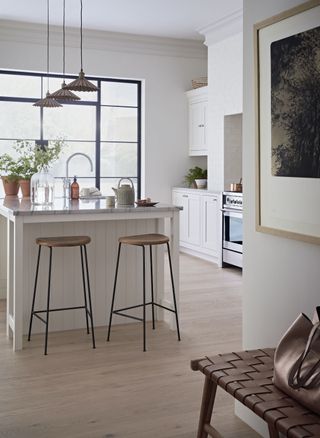
Glass kitchen worktops
Specifications
Reasons to buy
Reasons to avoid
What are glass worktops made from?
Glass used for kitchen surfaces is toughened, making it a very durable kitchen worktop. They are non-porous and are available in a variety of colors and finishes including ‘crackled’ or opaque. Recycled glass is also an option that mimics the look and feel of quartz, because of the reflections and refractions from colored glass chips.
How good is it as a kitchen worktop?
We've already said that it's non-porous – in other words, it won't stain. Glass also withstands moisture, and spills and splashes can easily be wiped clean, making it a beautiful – and practical – kitchen worktop material. Most glass worktops are heat-resistant, too for your hot pots and pans. In terms of price, glass is a pretty pricey kitchen worktop material.
Ease of maintenance
Your glass worktops will need to be wiped down regularly to prevent any watermarks (and get rid of the fingerprints), but they are incredibly hygienic as there are no joints or texture to allow anything unpleasant to build up.
Downsides?
Glass worktops can be prone to scratches and show off fingerprints; the latter can of course quickly be polished smooth.
Marble
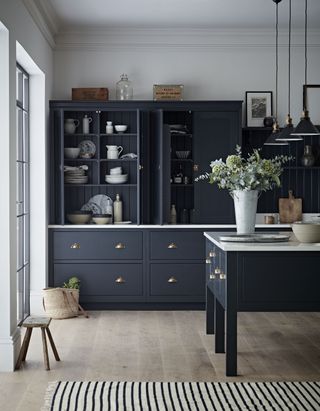
Marble kitchen worktops
Specifications
Reasons to buy
Reasons to avoid
What is marble?
Marble is a hard crystalline form of limestone, historically used in architecture and sculpture, hence its associations with classical elegance and luxury. Injecting a little marble into your space is one of the easiest ways to nod to luxury kitchen ideas without going all out. One of the best kitchen worktops for a super high-end finish.
How good is it as a kitchen worktop?
Marble looks incredibly elegant, and should be on your radar if you want a luxury, statement kitchen. This material is also always cool to the touch (due to its poor heat-conducting properties) – a valuable functional trait in a hot, steamy kitchen. It's also pretty dense and durable.
The main problem with marble is that it is a high-maintenance material, vulnerable to staining and scratching, so may not be the best choice in a busy family kitchen. Plus it reacts to acid, so an acidic kitchen liquid like lemon juice or vinegar will etch marble, leaving a dull, whitish mark where it has slightly eaten away the surface, even after the marble has been sealed. To clean marble countertops, use a mild, non-abrasive, pH-neutral (non-acidic) soap mixed with water and a soft cloth. You could also get a specialist marble worktop cleaner, like this scented Method cleaner available on Amazon.
The downsides?
You need to be careful when cooking with acidic foods and choose cleaning products wisely.
Solid surface composite
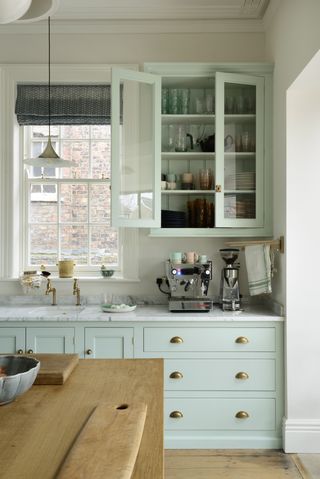
Solid surface composite kitchen worktops
Specifications
Reasons to buy
Reasons to avoid
What are solid surface composite worktops?
These are made by applying an acrylic resin to the top of a substrate material like wood.
How good are they as kitchen worktops?
These solid surface materials are great for modern kitchens. Made from a blend of acrylic resins, minerals, and colors, solid surfaces, and Corian can be totally seamless, too, with one-piece runs, molded sinks, and splashbacks all possible. They are heat and scratch-resistant to a point, but can’t compete with solid stone or quartz. They’re non-porous, making them hygienic and dirt/bacteria resistant – but bear in mind that although the resin exterior is waterproof, if any water gets within the substrate material, it can cause irreparable damage.
Ease of maintenance
They are pretty low maintenance in terms of cleaning, requiring no initial treatment; you just clean with a soft cloth and mild detergent.
The downsides?
Although it's hard to damage them, once damaged, they're not easy to repair.
Stainless steel
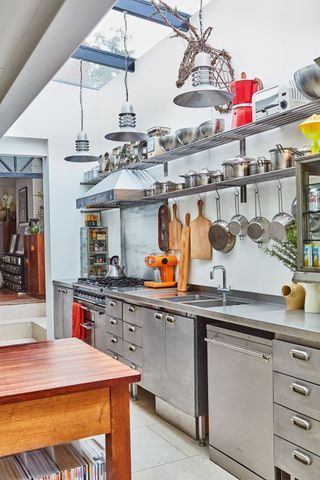
Stainless steel kitchen worktops
Specifications
Reasons to buy
Reasons to avoid
Why a stainless steel worktop?
Stainless steel is becoming an increasingly popular kitchen worktop material with the rise of the industrial trend, and it's one of the best kitchen worktops for a home where lots of cooking happens. You might think it's a bit much over every surface but why not use it to make a statement and take advantage of its benefits on a kitchen island or in a small workspace? Have a look at our gallery of inspiring industrial style kitchens for ideas.
How good is it as a kitchen worktop?
Stainless steel is super strong, waterproof, heat and acid resistant. It is prone to scratching, but we reckon this just adds to the worn in look, plus ageing won’t affect its anti-bacterial qualities. If you would prefer for the scratches not to be as obvious, go for a slightly matte finish.
Ease of cleaning
It is very easy to keep clean with stainless-steel cleaner. And a great cleaning hack to get rid of inevitable fingerprints is to use a touch of baby oil to keep it looking at its shiny best. Get more tips on how to clean stainless steel in our expert guide.
The downsides?
The scratches do show up, but if you can live with that as part of the look, you're home dry. For some, this material will be too clinical for a family home – but if it works for you, it can be a really lovely and functional option.
Ceramic
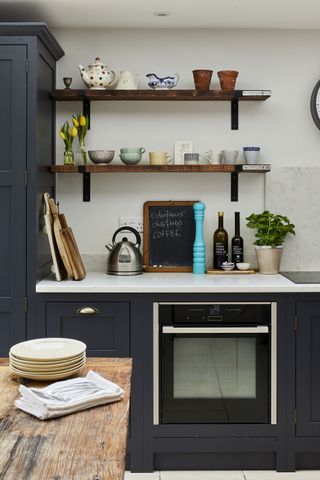
Ceramic kitchen worktops
Specifications
Reasons to buy
Reasons to avoid
What's ceramic like as a kitchen worktop material?
Ceramic worktops are popular because they’re versatile and super hygienic. It's an extremely hard-wearing and durable surface that is resistant to water, mildew, mold, and bacteria.
Ease of cleaning
Make sure you clean away any spills straight away to prevent staining. Use a damp cloth and warm water for cleaning and if needed, use a mild acidic detergent. Avoid anything that contains bleach.
The downsides?
Ceramic can be prone to scratches, so you'll need to be careful not to mark it when cooking. For this reason, it's likely not the best option for busy family homes.
How to choose the best kitchen worktops
When you first come to select a kitchen countertop, think about how you will be using them to better understand how hardwearing and easy to maintain they need to be.
If you prepare and cook food from scratch everyday, which requires lots of cleaning and chopping, this means you will need something resilient, which will keep its quality with regular use of cleaning products. Or, if you tend to entertain more and use the surface less vigorously, you can probably afford to go with something likely a little cheaper but still aesthetically pleasing.
Your kitchen worktops are a natural focal point in your kitchen, so consider the following to help you choose the most practical choice of worktop material that will complement your kitchen cabinets, flooring and other elements in your space too.
- Are you prepared to maintain kitchen worktops that need it (ie, marble, wood) or do you want a maintenance-free material?
- Do you tend to put hot pans straight on the work surface, or will you use a trivet?
- Are you prepared for the upkeep of a high gloss work surface, or would a matte finish be better suited to your family (i.e, you have small children who like to touch everything)?
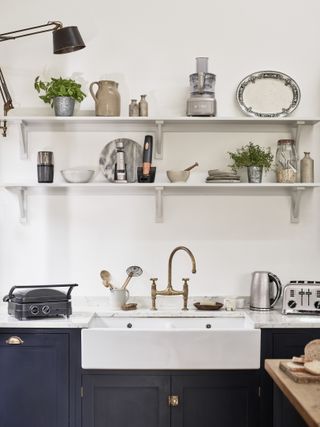
Picking the best kitchen worktop for you
The primary factor to consider when looking at the best kitchen worktops is material. The most common options are stone, wood, man-made composite, and laminate, and each has its own unique properties.
Natural stone and wood, with their varied colors and markings, look stunning in a traditional kitchen but can scratch and stain, requiring sealing and regular maintenance.
A fuss-free alternative is a man-made composite material, such as quartz or Corian, which blends natural minerals with resin to create highly durable surfaces that are non-porous and easy to clean. However, these can be costly and require specialist fitting.
If you’re on a budget, laminates are the best choice. Comprising a plastic overlay and design layer bonded to the man-made board, they can mimic hundreds of finishes, from weathered wood to veined marble, at a fraction of the price, while also being water resistant.
Alternatively, zinc, stainless steel, and concrete are becoming increasingly popular as a way to achieve an on-trend industrial look..
FAQs
What is the best kitchen worktop for DIY fitting?
If you’re sufficiently handy and confident in your skills, you could fit a wood or laminate kitchen worktop yourself to save money. Stone, quartz, and solid surfaces will require you to get someone in for a professional installation. Bear in mind that a stone like granite is heavy, so cabinets must offer sufficient support.
Where can I buy the best kitchen worktops?
Specialist natural stone and composite worktops are usually included as part of a bespoke fitted kitchen and supplied by the cabinetmaker. However non-specialist laminates and some timber worktops can be bought in standard sizes or by the meter, then cut to size and fitted by a tradesperson or you, if you are fitting your own kitchen.
How do I maintain and clean kitchen worktops?
The best kitchen worktops are big investments so, once installed, make sure you know how to care for them – the kitchen supplier will usually advise, and you can see our recommendations above. For impenetrable man-made composites and laminates, soap and water or a mild detergent is all that’s required, but wooden worktops, which are easily damaged, will need oiling at least once a year.
Join our newsletter
Get small space home decor ideas, celeb inspiration, DIY tips and more, straight to your inbox!
Lucy is Global Editor-in-Chief of Homes & Gardens having worked on numerous interiors and property titles. She was founding Editor of Channel 4’s 4Homes magazine, was Associate Editor at Ideal Home, before becoming Editor-in-Chief of Realhomes.com in 2018 then moving to Homes & Gardens in 2021. She has also written for Huffington Post, AOL, UKTV, MSN, House Beautiful, Good Homes, and many women’s titles. Find her writing about everything from buying and selling property, self build, DIY, design and consumer issues to gardening.